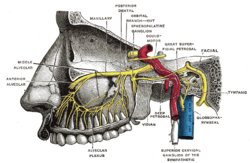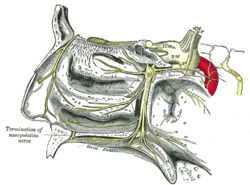Sphenopalatine ganglion
| Pterygopalatine ganglion | |
|---|---|

Alveolar branches of superior maxillary nerve and pterygopalatine ganglion
|
|

The pterygopalatine ganglion and its branches (pterygopalatine ganglion visible but not labeled, as large yellow ganglion in upper-right center)
|
|
| Details | |
| From | Maxillary nerve and nerve of pterygoid canal |
| To | Greater palatine nerve, lesser palatine nerve, posterior lateral nasal branches and nasopalatine nerve |
| Identifiers | |
| Latin | Ganglion pterygopalatinum |
| TA | A14.3.02.006 |
| FMA | 6965 |
|
Anatomical terms of neuroanatomy
[]
|
|
The pterygopalatine ganglion (Meckel's ganglion, nasal ganglion or sphenopalatine ganglion) is a parasympathetic ganglion found in the pterygopalatine fossa. It is largely innervated by the greater petrosal nerve (a branch of the facial nerve); and its axons project to the lacrimal glands and nasal mucosa. The flow of blood to the nasal mucosa, in particular the venous plexus of the conchae, is regulated by the pterygopalatine ganglion and heats or cools the air in the nose. It is one of four parasympathetic ganglia of the head and neck, the others being the submandibular ganglion, otic ganglion, and ciliary ganglion.
The pterygopalatine ganglion (of Meckel), the largest of the parasympathetic ganglia associated with the branches of the maxillary nerve, is deeply placed in the pterygopalatine fossa, close to the sphenopalatine foramen. It is triangular or heart-shaped, of a reddish-gray color, and is situated just below the maxillary nerve as it crosses the fossa.
The pterygopalatine ganglion supplies the lacrimal gland, paranasal sinuses, glands of the mucosa of the nasal cavity and pharynx, the gingiva, and the mucous membrane and glands of the hard palate. It communicates anteriorly with the nasopalatine nerve.
It receives a sensory, a parasympathetic, and a sympathetic root.
Its sensory root is derived from two sphenopalatine branches of the maxillary nerve; their fibers, for the most part, pass directly into the palatine nerves; a few, however, enter the ganglion, constituting its sensory root.
...
Wikipedia
